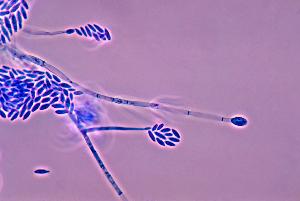
This genome was sequenced by the Broad
Institute.
Fusarium verticillioides is the causal agent of kernel
and ear rot of maize. This destructive disease occurs virtually
everywhere that maize is grown worldwide. In years with high
temperatures, drought, and heavy insect damage, the disease can
significantly diminish crop quality. The most significant economic
impact of F. verticillioides is its ability to produce
fumonisin mycotoxins. Various diseases caused by fumonisins have
been reported in animals, such as liver and kidney cancer as well
as neural tube defects in rodents, leukoencephalomalacia in
equines, and pulmonary edema in pigs. More importantly,
epidemiological correlations have been established between human
esophageal cancer and the consumption of fumonisin-contaminated
maize in some regions of the world where maize is a dietary staple.
In addition, fumonisins have been reported to be a potential cause
of neural tube defects in humans. Due to potential health risks,
guidelines for fumonisin levels in food have been established by
the US FDA and by other government agencies worldwide. In 2003,
fumonisin B1, the fumonisin produced most abundantly by F.
verticillioides, was added to the California Proposition 65
List of Substances Known to Cause Cancer.
Genome Reference(s)
Ma LJ, van der Does HC, Borkovich KA, Coleman JJ, Daboussi MJ, Di Pietro A, Dufresne M, Freitag M, Grabherr M, Henrissat B, Houterman PM, Kang S, Shim WB, Woloshuk C, Xie X, Xu JR, Antoniw J, Baker SE, Bluhm BH, Breakspear A, Brown DW, Butchko RA, Chapman S, Coulson R, Coutinho PM, Danchin EG, Diener A, Gale LR, Gardiner DM, Goff S, Hammond-Kosack KE, Hilburn K, Hua-Van A, Jonkers W, Kazan K, Kodira CD, Koehrsen M, Kumar L, Lee YH, Li L, Manners JM, Miranda-Saavedra D, Mukherjee M, Park G, Park J, Park SY, Proctor RH, Regev A, Ruiz-Roldan MC, Sain D, Sakthikumar S, Sykes S, Schwartz DC, Turgeon BG, Wapinski I, Yoder O, Young S, Zeng Q, Zhou S, Galagan J, Cuomo CA, Kistler HC, Rep M
Comparative genomics reveals mobile pathogenicity chromosomes in Fusarium.
Nature. 2010 Mar 18;464(7287):367-73. doi: 10.1038/nature08850
Cuomo CA, Güldener U, Xu JR, Trail F, Turgeon BG, Di Pietro A, Walton JD, Ma LJ, Baker SE, Rep M, Adam G, Antoniw J, Baldwin T, Calvo S, Chang YL, Decaprio D, Gale LR, Gnerre S, Goswami RS, Hammond-Kosack K, Harris LJ, Hilburn K, Kennell JC, Kroken S, Magnuson JK, Mannhaupt G, Mauceli E, Mewes HW, Mitterbauer R, Muehlbauer G, Münsterkötter M, Nelson D, O'donnell K, Ouellet T, Qi W, Quesneville H, Roncero MI, Seong KY, Tetko IV, Urban M, Waalwijk C, Ward TJ, Yao J, Birren BW, Kistler HC
The Fusarium graminearum genome reveals a link between localized polymorphism and pathogen specialization.
Science. 2007 Sep 7;317(5843):1400-2. doi: 10.1126/science.1143708
